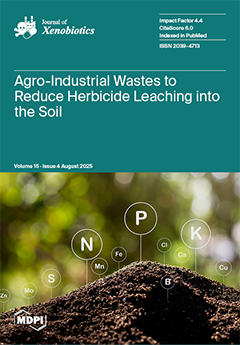The knowledge about the potential toxic effects of microplastics (MPs) combined with herbicides at lower trophic levels is still largely unknown. The present study aimed to evaluate the potential toxic effects of polyethylene terephthalate (PET) and polyamide (PA), isolated or combined with the pesticide glyphosate (GLY), on the microalgae
Arthrospira platensis. For this, microalgae were exposed to control, GLY (3 μg/L), PET (0.5 and 1 mg/L), PA (0.5 and 1 mg/L), and the respective mixtures of each MP with GLY, for 12 days. The photosynthetic pigment content, phytochemicals, antioxidants, and enzymatic activity were determined. Cell growth was significantly enhanced on day 4 in the GLY+PA1 group (~80%), compared to the control. At day 12, biomass was significantly higher in the GLY (~25%) and GLY+PET0.5 (~26%) groups relative to the control. Significant effects on the enzymatic and detoxification mechanisms were observed, including increased SOD (PET0.5,
p = 0.011) and CarE (GLY, PA and GLY+PA,
p < 0.01), and decreased GST in combined exposures, which support stress-induced enzymatic activation and adaptive biochemical responses. Significant effects on phytochemicals and antioxidant activity were also observed, with PET0.5 significantly reducing total carotenoids (~65%), and flavonoids (
p < 0.001) and ortho-diphenols (
p < 0.05) being decreased in all exposure groups, in comparison to the control group. The decrease in flavonoids and ortho-diphenols, important antioxidant molecules, suggests the depletion of these key compounds under stress. DPPH scavenging activity, a measure of antioxidant potential, was inhibited in the GLY+PA groups, indicating compromised antioxidant defense. Results confirmed that combined stressors elicit distinct and sometimes deleterious responses not predicted by single exposures. Our findings highlight that the combined exposure to glyphosate and MPs significantly disrupts antioxidant defenses and enzymatic activity in
A. platensis, indicating potential risks to primary producers in aquatic ecosystems and underscoring the ecological implications of co-contaminant stressors. In fact, the results indicate that MPs can modify herbicide toxicity, posing enhanced risks to microalgal physiology and potentially affecting primary productivity and nutrient cycling in aquatic ecosystems. In turn, negative effects of MPs on microalgae can have serious consequences for food webs, food security, and ecological health.
Full article






